 Science in Christian Perspective
Science in Christian PerspectiveSince 1941
 Science in Christian Perspective
Science in Christian Perspective
Since 1941
Faith-Science News
scientific reports and views related to ASA concerns
Richard
von Sternberg Case Science in the Public
School
18 Nov--Faith-Science News has moved. Faith Science News continues in a blog format.
You can also subscribe via RSS. See the ASA Home Page for details.
 31
Aug--Environment
key to helping poor A new report concludes that the
Millennium Development Goals cannot be met without
environmental progress. BBCNews
31
Aug--Environment
key to helping poor A new report concludes that the
Millennium Development Goals cannot be met without
environmental progress. BBCNews
31 Aug--XMM-Newton probes formation of galaxy clusters ESA's X-ray observatory, XMM-Newton, has for the first time allowed scientists to study in detail the formation history of galaxy clusters, not only with single arbitrarily selected objects, but with a complete representative sample of clusters. EurekAlert
31 Aug--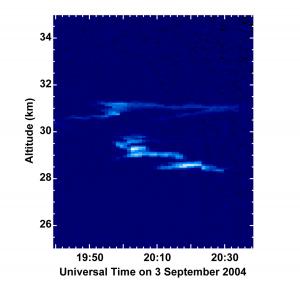
![]() Asteroid
Dust May Influence Weather, Study Finds
In a study to be
published this week in the journal Nature, scientists from
the Australian Antarctic Division, the University of
Western Ontario, the Aerospace Corporation, and Sandia and
Los Alamos national laboratories found evidence that dust
from an asteroid burning up as it descended through
Earth's atmosphere formed a cloud of micron-sized
particles significant enough to influence local weather in
Antarctica. ScienceDaily
Asteroid
Dust May Influence Weather, Study Finds
In a study to be
published this week in the journal Nature, scientists from
the Australian Antarctic Division, the University of
Western Ontario, the Aerospace Corporation, and Sandia and
Los Alamos national laboratories found evidence that dust
from an asteroid burning up as it descended through
Earth's atmosphere formed a cloud of micron-sized
particles significant enough to influence local weather in
Antarctica. ScienceDaily
31 Aug--Finding
A Way To Test For Dark Energy Physics
models of dark energy can be separated into distinct
scenarios, which could be 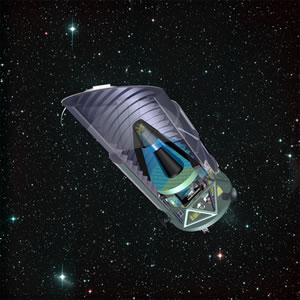 used
to rule out Einstein's cosmological constant and
distinguish among two major classes of dynamic
quintessence, a thawing model and a freezing model. Which
scenario makes the best fit can be tested with the Joint
Dark Energy Mission (JDEM) proposed by NASA and the U.S.
Department of Energy. ScienceDaily
used
to rule out Einstein's cosmological constant and
distinguish among two major classes of dynamic
quintessence, a thawing model and a freezing model. Which
scenario makes the best fit can be tested with the Joint
Dark Energy Mission (JDEM) proposed by NASA and the U.S.
Department of Energy. ScienceDaily
31 Aug--Spongy
nanocoating makes for fog-free glass  Easy
technology could soon be on car windscreens. Nature
Easy
technology could soon be on car windscreens. Nature
31 Aug-- Vermont
Blends 'Green' Flush Toilets and a Greenhouse
The state has installed a system that uses plants and
organisms to clean wastewater at a rebuilt rest stop on
Interstate 89. KATIE
ZEZIMA, NYTimes
Vermont
Blends 'Green' Flush Toilets and a Greenhouse
The state has installed a system that uses plants and
organisms to clean wastewater at a rebuilt rest stop on
Interstate 89. KATIE
ZEZIMA, NYTimes
31 Aug--Teaching
of Creationism Is Endorsed in New Survey
A poll found that nearly two-thirds of Americans say that
creationism should be taught alongside evolution in public
schools. LAURIE
GOODSTEIN, NYTimes
 Technology team have made a prototype that they hope
will soon be ready to use clinically. Their findings
appear in the journal Angewandte
Chemie. BBCNews
Technology team have made a prototype that they hope
will soon be ready to use clinically. Their findings
appear in the journal Angewandte
Chemie. BBCNews
The dye attaches to and shows up brain lesions
30 Aug--Snowball Antarctica ñ early Drake passage opening led to global change New results shed light on how Antarctica became the icy, barren continent that we know today. British Antarctic Survey (BAS) scientists have discovered that 30-50 million years ago, South America and Antarctica split apart very rapidly. This formed the Drake Passage and resulted in a major global cooling. The findings are published in the latest issue of Earth and Planetary Science Letters. EurekAlert
30 Aug--Saturn
moon delights and baffles Space
scientists say their discoveries about Saturn's moon
Enceladus are stunning, if just a little ![]() baffling.
BBCNews
baffling.
BBCNews
30 Aug--Mirror,
Mirror Astronomers
racing to build the biggest telescope ever are engaged in a
feat of optical derring-do (not to mention fund-raising). DENNIS
OVERBYE, NYTimes
fund-raising). DENNIS
OVERBYE, NYTimes
ï Graphic
30
Aug--Gold
bowties may shed light on molecules and other nano-sized
objects
One
of the great challenges in nanotechnology is designing a
microscope that produces high-resolution images of nano-sized
objects. Now Stanford researchers have greatly improved the
optical mismatch between nano-objects and light by creating
the "bowtie nanoantenna," a tiny device that
compresses ordinary light waves into an intense spotlight
only 20 nanometers wide. EurekAlert
30 Aug--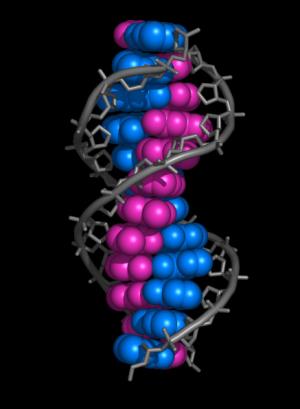
![]() New
Look At DNA Hints At Origin Of Ultraviolet Damage
Chemists at Ohio State
University have gained new insight into how sunlight affects
DNA. And what they found overturns ideas about genetic
mutation that originated decades ago. In the current issue
of the journal Nature, Bern Kohler and his colleagues report
that DNA dissipates the energy from ultraviolet (UV)
radiation in a kind of energy wave that travels up the edge
of the DNA molecule, as if the energy were climbing one side
of the helical DNA "ladder." Science Daily
New
Look At DNA Hints At Origin Of Ultraviolet Damage
Chemists at Ohio State
University have gained new insight into how sunlight affects
DNA. And what they found overturns ideas about genetic
mutation that originated decades ago. In the current issue
of the journal Nature, Bern Kohler and his colleagues report
that DNA dissipates the energy from ultraviolet (UV)
radiation in a kind of energy wave that travels up the edge
of the DNA molecule, as if the energy were climbing one side
of the helical DNA "ladder." Science Daily
30 Aug--Scientific Savvy? In U.S., Not Much The findings of Jon D. Miller, a political scientist, about how much Americans know. CORNELIA DEAN, NYTimes
30 Aug--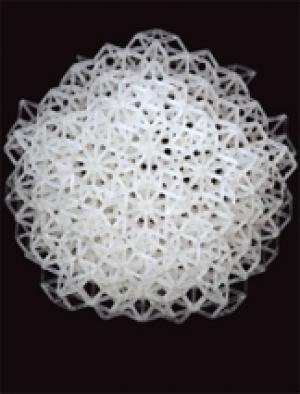
![]() New
Method For Trapping Light May Improve Communications
Technologies A
discovery by Princeton researchers may lead to an efficient
method for controlling the transmission of light and improve
new generations of communications technologies powered by
light rather than electricity. The discovery could be used
to develop new structures that would work in the same
fashion as an elbow joint in plumbing by enabling light to
make sharp turns as it travels through photonic circuits.
Fiber-optic cables currently used in computers, televisions
and other devices can transport light rapidly and
efficiently, but cannot bend at sharp angles. ScienceDaily
New
Method For Trapping Light May Improve Communications
Technologies A
discovery by Princeton researchers may lead to an efficient
method for controlling the transmission of light and improve
new generations of communications technologies powered by
light rather than electricity. The discovery could be used
to develop new structures that would work in the same
fashion as an elbow joint in plumbing by enabling light to
make sharp turns as it travels through photonic circuits.
Fiber-optic cables currently used in computers, televisions
and other devices can transport light rapidly and
efficiently, but cannot bend at sharp angles. ScienceDaily
29 Aug--Boost
to CO2 mass extinction idea A computer simulation of
the Earth's climate 250 million years ago suggests that
climate warming triggered  the
so-called "great dying". BBC News
the
so-called "great dying". BBC News
29 Aug--Gender Hormones May Lend To Social Disorder Therapies Researchers at UW-Madison have made the surprising finding that estrogen-and even dopamine, a neurotransmitter-also play critical roles in the development of aggressive social play behaviors. ScienceDaily
29 Aug--Researchers shed more light on conversion of water to hydrogen gas Chemists are several steps closer to teasing hydrogen fuel from water using man-made molecular devices that collect electrons and use them to split hydrogen from oxygen. EurekAlert
29 Aug--Robot-assisted prostate surgery has possible benefits, high cost Although minimally invasive prostate removal aided by a robot can lead to less blood loss, shorter hospital stays and fewer complications, there is no evidence that the procedure improves cure rates, according to a new technology assessment. EurekAlert
29 Aug--Homeopathy's
benefit questioned
A leading medical journal has made a
damning attack on homeopathy, saying it is no better than
dummy drugs. The  Lancet
says the time for more studies is over and doctors should be
bold and honest with patients about homeopathy's "lack of
benefit". A Swiss-UK review of 110 trials found no
convincing evidence the treatment worked any better than a
placebo. Advocates of homeopathy maintained the therapy, which
works on the principle of treating like with like, does work.
Lancet
says the time for more studies is over and doctors should be
bold and honest with patients about homeopathy's "lack of
benefit". A Swiss-UK review of 110 trials found no
convincing evidence the treatment worked any better than a
placebo. Advocates of homeopathy maintained the therapy, which
works on the principle of treating like with like, does work.
Heavily diluted solutions are used in homeopathic remedies
29 Aug--Robot-assisted prostate surgery has possible benefits, high cost Although minimally invasive prostate removal aided by a robot can lead to less blood loss, shorter hospital stays and fewer complications, there is no evidence that the procedure improves cure rates, according to a new technology assessment. EurekAlert
29 Sep--Early Look at Research Project to Re-engineer the Internet The National Science Foundation is planning an effort to create a network more suited to the computerized world of the next decade. JOHN MARKOFF NYTimes
![]() 26
Aug--Scientists
probe anti-ageing gene US scientists find a gene in mice
which plays a key role in the ageing process. BBCNews
26
Aug--Scientists
probe anti-ageing gene US scientists find a gene in mice
which plays a key role in the ageing process. BBCNews
26 Aug--Physicists Describe A New Mechanism For Metallic Magnetism Predicting the magnetic behavior of metallic compounds is a surprisingly difficult problem for theoretical physicists. While the properties of a common refrigerator magnet are not a great mystery, ScienceDaily
26 Aug--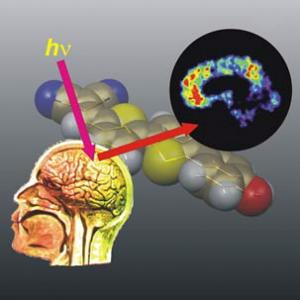
![]() New
Dye Could Offer Early Test For Alzheimer's; MIT Technique Is
Noninvasive MIT
scientists have developed a new dye that could offer
noninvasive early diagnosis of Alzheimer's disease, a
discovery that could aid in monitoring the progression of the
disease and in studying the efficacy of new treatments to stop
it. The new dye, called NIAD-4, was developed through a
targeted design process based on a set of specific
requirements, including the ability to enter the brain rapidly
upon injection, bind to amyloid plaques, absorb and fluoresce
radiation in the right spectral range, and provide sharp
contrast between the plaques and the surrounding tissue. ScienceDaily
New
Dye Could Offer Early Test For Alzheimer's; MIT Technique Is
Noninvasive MIT
scientists have developed a new dye that could offer
noninvasive early diagnosis of Alzheimer's disease, a
discovery that could aid in monitoring the progression of the
disease and in studying the efficacy of new treatments to stop
it. The new dye, called NIAD-4, was developed through a
targeted design process based on a set of specific
requirements, including the ability to enter the brain rapidly
upon injection, bind to amyloid plaques, absorb and fluoresce
radiation in the right spectral range, and provide sharp
contrast between the plaques and the surrounding tissue. ScienceDaily
 26
Aug--Lasers
trigger cleaner fusion Neutron-free
reaction makes less radioactive waste. Nature
26
Aug--Lasers
trigger cleaner fusion Neutron-free
reaction makes less radioactive waste. Nature
26 Aug--Scientists Say Earth's Center Rotates Faster Than Surface A team of geophysicists is presenting data on Friday showing that the earth's inner core spins faster than the rest of the planet. KENNETH CHANG, NYTimes
25 Aug--Europe
aims lone rover for Mars Europe has fixed on a
single robot rover concept for its next mission to land on the
Red  Planet.
BBCNews
Planet.
BBCNews
25 Aug--Stem
cells with heart bypass surgery trial to begin at University of
Pittsburgh The
University of Pittsburgh Medical Center has been granted
approval by the U.S. Food and Drug Administration to conduct a
clinical trial to determine the safety and feasibility of
injecting a patient's own bone marrow-derived stem cells
directly into the heart during conventional heart bypass
surgery. The trial will involve patients with ischemic heart
disease who are scheduled for off-pump (beating heart) coronary
artery bypass grafting surgery. EurekAlert
25 Aug--Brain
Plays Key Role In Regulating Bone Density The
brain plays an important role in the maintenance of proper bone
density, researchers at the Hebrew University of Jerusalem have
revealed. ScienceDaily
25 Aug--Chickens Orient Using A Magnetic Compass Many species of birds use the Earth's magnetic field to select a direction of movement. However, until now it has not been possible to train birds to move in a certain direction in the laboratory, even if they are motivated by a food reward. Researchers now report that they have been able to successfully accomplish this training task, providing new insight into the evolution of magnetic sensing and opening new opportunities for further study of magnetoreception. ScienceDaily
25 Aug--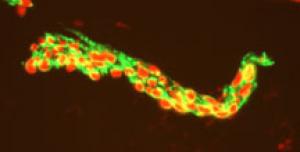
![]() Scientists
Make First Step Towards Growing Human Lungs For Transplant
Scientists have successfully
converted human embryonic stem cells into lung cells, taking a
first step towards building human lungs for transplantation.
According to research to be published in the journal Tissue
Engineering, the team from Imperial College London, took
human embryonic stem cells and 'directed' them to convert into
the type of cells needed for gas exchange in the lung, known as
mature small airway epithelium. NewScientist
Scientists
Make First Step Towards Growing Human Lungs For Transplant
Scientists have successfully
converted human embryonic stem cells into lung cells, taking a
first step towards building human lungs for transplantation.
According to research to be published in the journal Tissue
Engineering, the team from Imperial College London, took
human embryonic stem cells and 'directed' them to convert into
the type of cells needed for gas exchange in the lung, known as
mature small airway epithelium. NewScientist
25 Aug--Pakistan Now Says Scientist Did Send Koreans Nuclear Gear Pakistan's president confirmed that Dr. Abdul Qadeer Khan provided machines that could be used to make fuel for an atomic bomb. SALMAN MASOOD and DAVID ROHDE, NYTimes
24 Aug--Water
returns to Iraqi marshlands
The marshlands of Iraq, which were drained
during the early 1990s, are returning to their original state.
Under Saddam Hussein, the area of marsh was reduced to a tenth of its
former size, as the government punished people living there for
acts of rebellion. The latest United Nations data shows that
nearly 40% of the area has been restored to its original
condition. Drinking water and sanitation projects are under way,
but the UN says that a full recovery will take many years.
BBCNews
Saddam Hussein, the area of marsh was reduced to a tenth of its
former size, as the government punished people living there for
acts of rebellion. The latest United Nations data shows that
nearly 40% of the area has been restored to its original
condition. Drinking water and sanitation projects are under way,
but the UN says that a full recovery will take many years.
BBCNews
The marshland area has many channels which serve as byways
24 Aug--Now You See It, Now You Don't: 'Change Blindness' Isn't Magic A team of scientists at UCL (University College London) has discovered why we often miss major changes in our surroundings - such as a traffic light turning green when we're listening to the radio. Our inability to notice large changes in a visual scene is a phenomenon often exploited by magicians - but only now can scientists put their finger on the exact part of the brain that is so often deceived. ScienceDaily
24 Aug--![]() Physicists
Entangle Photon And Atom In Atomic Cloud
Physicists at the Georgia Institute of Technology have just
reached an important milestone in the development of quantum
communications networks by entangling a photon and a single atom
located in an atomic cloud. Researchers believe this is the
first time an entanglement between a photon and a collective
excitation of atoms has passed the rigorous test of quantum
behavior known as a Bell inequality violation. ScienceDaily
Physicists
Entangle Photon And Atom In Atomic Cloud
Physicists at the Georgia Institute of Technology have just
reached an important milestone in the development of quantum
communications networks by entangling a photon and a single atom
located in an atomic cloud. Researchers believe this is the
first time an entanglement between a photon and a collective
excitation of atoms has passed the rigorous test of quantum
behavior known as a Bell inequality violation. ScienceDaily
24 Aug--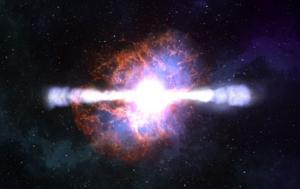
![]() NASA's
Swift Satellite Finds Newborn Black Holes Scientists
using NASA's Swift satellite say they have found newborn black
holes, just seconds old, in a confused state of existence. The
holes are consuming material falling into them while somehow
propelling other material away at great speeds. ScienceDaily
NASA's
Swift Satellite Finds Newborn Black Holes Scientists
using NASA's Swift satellite say they have found newborn black
holes, just seconds old, in a confused state of existence. The
holes are consuming material falling into them while somehow
propelling other material away at great speeds. ScienceDaily
24 Aug--Climate model links higher temperatures to prehistoric extinction Scientists at the National Center for Atmospheric Research have created a detailed computer simulation showing Earth's climate at the time of the greatest mass extinction in history. The work supports a theory that increased atmospheric levels of carbon dioxide triggered the Permian extinction 251 million years ago. EurekAlert
 24
Aug--Brain
cells tune in to music Neurons
respond selectively to distinct pitches. Nature
24
Aug--Brain
cells tune in to music Neurons
respond selectively to distinct pitches. Nature
23 Aug-- Scientific struggle Harold Evans on Bush's hostility to
science In his weekly opinion column, Harold Evans considers
rising concern in the US over the Bush administration's
hostility to science. BBCNews
Scientific struggle Harold Evans on Bush's hostility to
science In his weekly opinion column, Harold Evans considers
rising concern in the US over the Bush administration's
hostility to science. BBCNews
23 Aug--Scientists make first step towards growing human lungs for transplant Scientists have successfully converted human embryonic stem cells into lung cells, taking a first step towards building human lungs for transplantation. EurekAlert
23 Aug--![]()
![]() Early
Humans Wore 'Shoes' 30,000 Years Ago Our
modern day Nikes and Reeboks are direct descendents of the first
supportive footwear that new research suggests came into use in
western Eurasia between 26,000 and 30,000 years ago. Erik
Trinkaus, professor of anthropology at Washington University in
St. Louis, derived those dates by analyzing anatomical evidence
of early modern humans, which suggests a reduction in the
strength of the smaller toes in Upper Paleolithic humans while
there was little change in leg strength. ScienceDaily
Early
Humans Wore 'Shoes' 30,000 Years Ago Our
modern day Nikes and Reeboks are direct descendents of the first
supportive footwear that new research suggests came into use in
western Eurasia between 26,000 and 30,000 years ago. Erik
Trinkaus, professor of anthropology at Washington University in
St. Louis, derived those dates by analyzing anatomical evidence
of early modern humans, which suggests a reduction in the
strength of the smaller toes in Upper Paleolithic humans while
there was little change in leg strength. ScienceDaily
23 Aug--Beetle-inspired switch uses water for bonding A new switch designed by Cornell University engineers uses water droplets to create very strong adhesive bonds that can flicked on and off in an instant. The switch was inspired by a mechanism found in palm beetles and is described in the Proceedings of the National Academy of Sciences. EurekAlert
23 Aug--Saturn's
Rings Have Own Atmosphere Data
from the Cassini spacecraft indicate that Saturn's majestic ring
system has its own  atmosphere
- separate from that of the planet itself. During its close
fly-bys of the ring system, instruments on Cassini have been
able to determine that the environment around the rings is like
an atmosphere, composed principally of molecular oxygen. This
atmosphere is very similar to that of Jupiter's moons Europa and
Ganymede. ScienceDaily
atmosphere
- separate from that of the planet itself. During its close
fly-bys of the ring system, instruments on Cassini have been
able to determine that the environment around the rings is like
an atmosphere, composed principally of molecular oxygen. This
atmosphere is very similar to that of Jupiter's moons Europa and
Ganymede. ScienceDaily
23 Aug-- Under
the Old Neighborhood: In Iraq, an Archaeologist's Paradise
In Erbil, Iraq, the Citadel is a layer cake of civilizations
that may go back 100 centuries. Now, to begin digging without
displacing those on top. JAMES
GLANZ, NYTimes
Under
the Old Neighborhood: In Iraq, an Archaeologist's Paradise
In Erbil, Iraq, the Citadel is a layer cake of civilizations
that may go back 100 centuries. Now, to begin digging without
displacing those on top. JAMES
GLANZ, NYTimes
22 Aug--Carnegie Mellon University research reveals how cells process large genes Important messages require accurate transmission. Big genes are especially challenging. During processing, introns (non-coding elements) are snipped out and exons (coding segments) pasted together to form a template for proteins. How a cell's molecular machinery eliminates introns without making errors has puzzled scientists for years. Now, investigators at Carnegie Mellon have discovered that a novel mechanism removes long introns by steadily paring them down in a predictable fashion and joining the remaining exons. EurekAlert
22 Aug--First
kittens for cloned wildcats  US
scientists produce wildcat kittens by cross-breeding clones, a
move which could help with future preservation of endangered
species. BBCNews
US
scientists produce wildcat kittens by cross-breeding clones, a
move which could help with future preservation of endangered
species. BBCNews
22 Aug--Light That Travels ... Faster Than Light! A team of researchers from the Ecole Polytechnique FÈdÈrale de Lausanne (EPFL) has successfully demonstrated, for the first time, that it is possible to control the speed of light -- both slowing it ... > full story ScienceDaily
 22
Aug--Chimps
show sign of culture Chimpanzees
stick to the majority behaviour of their peers.
22
Aug--Chimps
show sign of culture Chimpanzees
stick to the majority behaviour of their peers.
22 Aug--A DEBATE OVER
DARWIN Politicized
Scholars Put Evolution on the Defensive
The Discovery Institute is the ideological and strategic backbone
behind the eruption of skirmishes over science in school districts
and state capitals across the country. JODI
WILGOREN, NYTimes
ï Graphic:
A Think Tank Rethinking Darwin
22 Aug--A DEBATE OVER
DARWIN In
Explaining Life's Complexity, Darwinists and Doubters Clash
Proponents
of intelligent design say biological marvels point to the hand of
a higher being, but mainstream scientists say such an explanation
is unscientific. KENNETH![]() CHANG, NYTimes
CHANG, NYTimes
19 Aug--![]() Early
humans 'may have spread TB' The tuberculosis bacterium emerged
three million years ago in Africa and may have been spread by
hominids. BBCNews
Early
humans 'may have spread TB' The tuberculosis bacterium emerged
three million years ago in Africa and may have been spread by
hominids. BBCNews
19 Aug--Monkey Wrench In Solar System Evolution A University of Toronto scientist has found unexpectedly 'young' material in meteorites -- a discovery that breaks open current theory on the earliest events of the solar system. A paper published today in the August issue of Nature reports that the youngest known chondrules ñ the small grains of mineral that make up certain meteorites ñ have been identified in the meteorites known as Gujba and Hammadah al Hamra. Researchers who have studied chondrules generally agree that most were formed as a sudden, repetitive heat, likely from a shock wave, condensed the nebula of dust floating around the early Sun. Thinking that an analysis of the chondrules in Gujba and Hammadah al Hamra would be appropriate for accurately dating this process, U of T geologist Yuri Amelin, together with lead author Alexander Krot of the University of Hawaii, studied the chondrulesí mineralogical structure and determined their isotopic age. ìIt soon became clear that these particular chondrules were not of a nebular origin,î says Amelin. ìAnd the ages were quite different from what was expected. It was exciting.îScienceDaily
19 Aug--
![]() Nitrogen
In The Air Feeds The Oceans A
new study provides the first direct evidence that atmospheric
nitrogen is an important nutrient for marine life. The finding
suggests a theoretical mechanism for removing carbon dioxide from
the atmosphere. Previous estimates suggested that nitrogen fixation
from the atmosphere played only a very minor role in the oceans. ScienceDaily
Nitrogen
In The Air Feeds The Oceans A
new study provides the first direct evidence that atmospheric
nitrogen is an important nutrient for marine life. The finding
suggests a theoretical mechanism for removing carbon dioxide from
the atmosphere. Previous estimates suggested that nitrogen fixation
from the atmosphere played only a very minor role in the oceans. ScienceDaily
19 Aug--Nanotube
sheets come of age Clear,
conductive sheets produced at high speed. Nature
19 Aug--Report by E.P.A. Offers Heartening News on Summertime Air A new report by the Environmental Protection Agency says ozone levels are falling in 19 Eastern states where bad air is common in the summer. MICHAEL JANOFSKY, NYTimes
18 Aug-- Big
game 'could roam US plains' If a US research group has their
way, lions, cheetahs and camels could soon roam parts of![]() North
America.
North
America.
18 Aug--
![]() How
Butterflies Fly Thousands Of Miles Without Getting Lost Revealed By
Researchers While
"navigation" systems in automobiles are a fairly new (and
still costly) innovation, monarch butterflies have managed for
millennia to navigate their way for a distance of some 3000 miles
(4800 kilometers) each fall from Canada to Mexico (and vice-versa in
the spring) without losing their way. The phenomenon of long-range
bird migration is a well-known one, but not in the insect world. Also,
among birds their migration route is a round-trip one, which they make
more than once in their lifetimes, while for the monarch it is
strictly a one-way trip for each butterfly. How do these creatures do
it? ScienceDaily
How
Butterflies Fly Thousands Of Miles Without Getting Lost Revealed By
Researchers While
"navigation" systems in automobiles are a fairly new (and
still costly) innovation, monarch butterflies have managed for
millennia to navigate their way for a distance of some 3000 miles
(4800 kilometers) each fall from Canada to Mexico (and vice-versa in
the spring) without losing their way. The phenomenon of long-range
bird migration is a well-known one, but not in the insect world. Also,
among birds their migration route is a round-trip one, which they make
more than once in their lifetimes, while for the monarch it is
strictly a one-way trip for each butterfly. How do these creatures do
it? ScienceDaily
18 Aug--Study shows some types of military interventions can slow or stop genocide A new study shows that interventions that directly challenge perpetrators of genocides and politicides save lives. EurekAlert
18 Aug--Species
hotspots hard to pin down Study
finds little overlap between hotspots based on different types of
biodiversity.  Nature
Nature
18 Aug--Fetal Skin Cells Found to Be a Promising Treatment for Burns Swiss scientists discovered that panels of artificial fetal skin seemed to confer restorative power to damaged tissue. ELISABETH ROSENTHAL, NYTimes
17 Aug--Strange
fossil defies grouping A
bizarre fossil from the early Cambrian Period is baffling scientists
because it does not seem to fit into any  existing
animal groups. BBCNews
existing
animal groups. BBCNews
17 Aug-Saturn's
rings have own atmosphere Data from the NASA/ESA/ASI
Cassini spacecraft indicate that Saturn's majestic ring system has its
own atmosphere - separate from that of the planet itself. EurekAlert
17 Aug--
![]() 'Smart'
Nanoprobes Light Up Disease: Quantum Dots Programmed To Glow In
Presence Of Enzyme Activity
'Smart'
Nanoprobes Light Up Disease: Quantum Dots Programmed To Glow In
Presence Of Enzyme Activity
Researchers from Rice University's Center for
Biological and Environmental Nanotechnology (CBEN) have developed a
"smart" beacon hundreds of times smaller than a human cell
that is programmed to light up only when activated by specific
diseases. Altered expression of particular proteases is a common
hallmark of cancer, atherosclerosis and other diseases. The research
appears in the September issue of the journal Biochemical and
Biophysical Research Communications. ScienceDaily
17 Aug--Purdue simulation to help merge molecules with silicon electronics Engineers at Purdue University have created a nanotech simulation tool that shows how current flows between silicon atoms and individual molecules to help researchers design "molecular electronic" devices for future computers and advanced sensors. Details are appearing in the current issue of Physical Review Letters. EurekAlert
17 Aug--Via
Internet, Australian-based Researchers Perform Real-time Cell Surgery
In California n
an effort to combine sophisticated  laser
and Internet technologies, scientists in Australia have successfully
performed laser surgery and "optical trapping" in a Southern
California laboratory via the Internet. The scientists used a new
Internet-based laser scissor-and-tweezers technology called RoboLase,
demonstrating the potential of using the technology for real-time
research activities between laboratories and for physicians to perform
medical procedures from distant locations. ScienceDaily
laser
and Internet technologies, scientists in Australia have successfully
performed laser surgery and "optical trapping" in a Southern
California laboratory via the Internet. The scientists used a new
Internet-based laser scissor-and-tweezers technology called RoboLase,
demonstrating the potential of using the technology for real-time
research activities between laboratories and for physicians to perform
medical procedures from distant locations. ScienceDaily
16
Aug-- Scientists
make nerve stem cells The world's first pure batch of
nerve stem cells made from human stem cells is created in Edinburgh,
scientists report. BBCNews
Edinburgh,
scientists report. BBCNews
16 Aug--Non-protestant second-generation Asian-Americans more likely to make personal choice about religion The religion preference of second-generation Asian-Americans is more likely to be influenced by their family tradition if they are Protestant but more by a personal faith choice if they belong to other religions. A sociologist at Rice University noted that by studying a new population, both in terms of religion and race, this research is a useful expansion to studies of family and religious transmission that have focused primarily on white Christians. EurekAlert
16 Aug--![]()
![]() Scientists
Crack 40-year-old DNA Puzzle And Point To 'Hot Soup' At The Origin Of
Life A new
theory that explains why the language of our genes is more complex than
it needs to be also suggests that the primordial soup where life began
on earth was hot and not cold, as many scientists believe. In a paper
published in the Journal of Molecular Evolution this week, researchers
from the University of Bath describe a new theory which they believe
could solve a puzzle that has baffled scientists since they first
deciphered the language of DNA almost 40 years ago.
Scientists
Crack 40-year-old DNA Puzzle And Point To 'Hot Soup' At The Origin Of
Life A new
theory that explains why the language of our genes is more complex than
it needs to be also suggests that the primordial soup where life began
on earth was hot and not cold, as many scientists believe. In a paper
published in the Journal of Molecular Evolution this week, researchers
from the University of Bath describe a new theory which they believe
could solve a puzzle that has baffled scientists since they first
deciphered the language of DNA almost 40 years ago.
 16
Aug--Nanotech
transistor powers up Carbon
nanotubes could make for smaller circuits. Nature
16
Aug--Nanotech
transistor powers up Carbon
nanotubes could make for smaller circuits. Nature
16 Aug--Einstein Guides My Steering Wheel In a time when many areas of fundamental research are facing drastic budget threats, it is worth remembering that even the most esoteric scientific ideas can ultimately affect one's daily life. LAWRENCE M. KRAUSS, NYTimes
16 Aug--Building
a Virtual Microbe, Gene by Gene by Gene
A group of scientists are trying to reconstruct a living organism,  Escherichia
coli, inside a computer, down to every last molecule. CARL
ZIMMER, NYTimes
Escherichia
coli, inside a computer, down to every last molecule. CARL
ZIMMER, NYTimes
15 Aug--Disasters do not necessarily affect minorities disproportionately While it has long been assumed in the disaster research community that individuals with fewer resources are more likely to suffer in a disaster -- and it is true that non-whites, the poor, and females often suffer more than their counterparts -- the race-class-and-gender trinity of variables does not capture the entire spectrum in which disaster affects society. EurekAlert
15 Aug--
![]() Mars
Express Radar Collects First Surface Data MARSIS,
the sounding radar on board ESA's Mars Express spacecraft, is collecting
the first data about the surface and the ionosphere of Mars. The first
ionospheric measurements performed by MARSIS have also revealed some
interesting preliminary findings. The radar responds directly to the
number of charged particles composing the ionosphere (plasma). This has
shown to be higher than expected at times. ScienceDaily
Mars
Express Radar Collects First Surface Data MARSIS,
the sounding radar on board ESA's Mars Express spacecraft, is collecting
the first data about the surface and the ionosphere of Mars. The first
ionospheric measurements performed by MARSIS have also revealed some
interesting preliminary findings. The radar responds directly to the
number of charged particles composing the ionosphere (plasma). This has
shown to be higher than expected at times. ScienceDaily
15 Aug--Bacteria
designed to make new antibiotics Approach
may produce tools to fight drug-resistant infections. Nature
haas.john@comcast.net